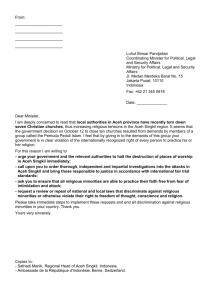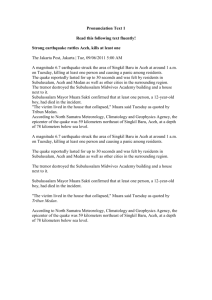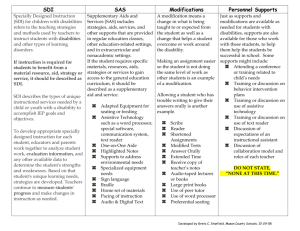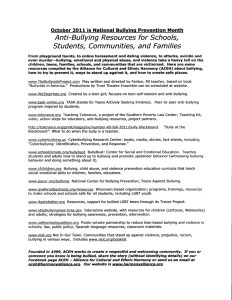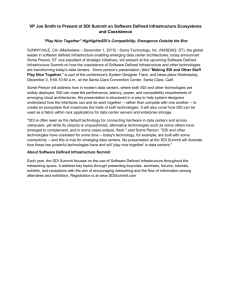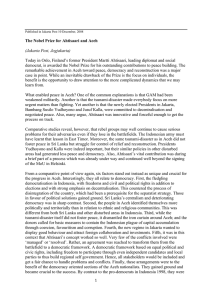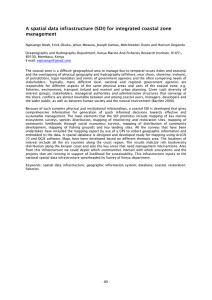SDI IN TWO DIVERSE CONTEXTS – ACEH & AUSTRALIA:
advertisement
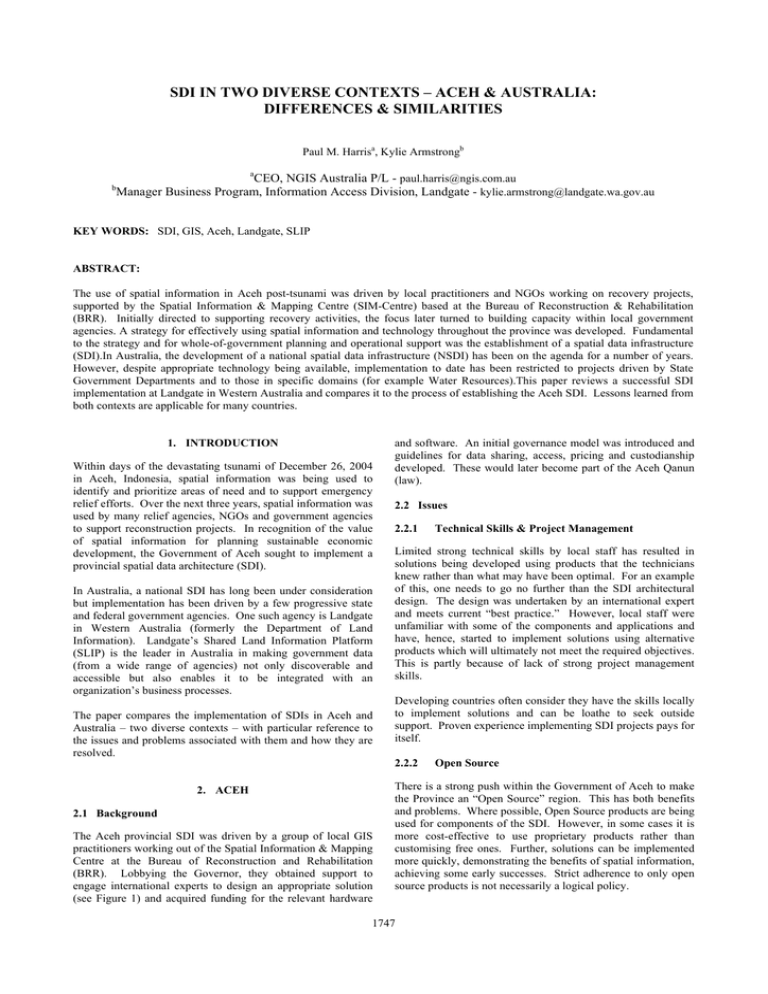
SDI IN TWO DIVERSE CONTEXTS – ACEH & AUSTRALIA: DIFFERENCES & SIMILARITIES Paul M. Harrisa, Kylie Armstrongb a CEO, NGIS Australia P/L - paul.harris@ngis.com.au Manager Business Program, Information Access Division, Landgate - kylie.armstrong@landgate.wa.gov.au b KEY WORDS: SDI, GIS, Aceh, Landgate, SLIP ABSTRACT: The use of spatial information in Aceh post-tsunami was driven by local practitioners and NGOs working on recovery projects, supported by the Spatial Information & Mapping Centre (SIM-Centre) based at the Bureau of Reconstruction & Rehabilitation (BRR). Initially directed to supporting recovery activities, the focus later turned to building capacity within local government agencies. A strategy for effectively using spatial information and technology throughout the province was developed. Fundamental to the strategy and for whole-of-government planning and operational support was the establishment of a spatial data infrastructure (SDI).In Australia, the development of a national spatial data infrastructure (NSDI) has been on the agenda for a number of years. However, despite appropriate technology being available, implementation to date has been restricted to projects driven by State Government Departments and to those in specific domains (for example Water Resources).This paper reviews a successful SDI implementation at Landgate in Western Australia and compares it to the process of establishing the Aceh SDI. Lessons learned from both contexts are applicable for many countries. 1. INTRODUCTION Within days of the devastating tsunami of December 26, 2004 in Aceh, Indonesia, spatial information was being used to identify and prioritize areas of need and to support emergency relief efforts. Over the next three years, spatial information was used by many relief agencies, NGOs and government agencies to support reconstruction projects. In recognition of the value of spatial information for planning sustainable economic development, the Government of Aceh sought to implement a provincial spatial data architecture (SDI). In Australia, a national SDI has long been under consideration but implementation has been driven by a few progressive state and federal government agencies. One such agency is Landgate in Western Australia (formerly the Department of Land Information). Landgate’s Shared Land Information Platform (SLIP) is the leader in Australia in making government data (from a wide range of agencies) not only discoverable and accessible but also enables it to be integrated with an organization’s business processes. The paper compares the implementation of SDIs in Aceh and Australia – two diverse contexts – with particular reference to the issues and problems associated with them and how they are resolved. and software. An initial governance model was introduced and guidelines for data sharing, access, pricing and custodianship developed. These would later become part of the Aceh Qanun (law). 2.2 Issues 2.2.1 Limited strong technical skills by local staff has resulted in solutions being developed using products that the technicians knew rather than what may have been optimal. For an example of this, one needs to go no further than the SDI architectural design. The design was undertaken by an international expert and meets current “best practice.” However, local staff were unfamiliar with some of the components and applications and have, hence, started to implement solutions using alternative products which will ultimately not meet the required objectives. This is partly because of lack of strong project management skills. Developing countries often consider they have the skills locally to implement solutions and can be loathe to seek outside support. Proven experience implementing SDI projects pays for itself. 2.2.2 2. ACEH 2.1 Background The Aceh provincial SDI was driven by a group of local GIS practitioners working out of the Spatial Information & Mapping Centre at the Bureau of Reconstruction and Rehabilitation (BRR). Lobbying the Governor, they obtained support to engage international experts to design an appropriate solution (see Figure 1) and acquired funding for the relevant hardware Technical Skills & Project Management Open Source There is a strong push within the Government of Aceh to make the Province an “Open Source” region. This has both benefits and problems. Where possible, Open Source products are being used for components of the SDI. However, in some cases it is more cost-effective to use proprietary products rather than customising free ones. Further, solutions can be implemented more quickly, demonstrating the benefits of spatial information, achieving some early successes. Strict adherence to only open source products is not necessarily a logical policy. 1747 The International Archives of the Photogrammetry, Remote Sensing and Spatial Information Sciences. Vol. XXXVII. Part B4. Beijing 2008 2.2.3 Policies Guidelines have been developed for data access, sharing and pricing and for standards for data management. However, the policies are not in place nor agreed to by all stakeholders. Consequently, even if an effective technical framework is developed, applications may stall because of lack of agreement among government agencies. The Government of Aceh is keen to formalize these policies but pressure of other issues has meant that to-date this has not occurred. 2.2.4 Rivalries Currently, cooperation among provincial government agencies in Aceh is quite strong because they can all see the benefits of working together to develop a whole-of-government solution and most are starting from a position of no expertise. However, at the national level, there are some disagreements, as the national mapping agency, Bakosurtanal, is attempting to implement a SDI. It has been trying to do so for some years without success, so the Government of Aceh has made the decision to implement their own solution. Bakosurtanal does not agree with this approach. However, technically, it should not be an issue if both groups implement solutions that comply to international standards. 2.2.5 Governance It remains unclear which agency in Aceh is responsible for the implementation of the SDI. Bappeda has taken the running on this, with the AGDC being located within its offices. A governance model has been designed but is yet to be implemented. These institutional issues frequently take “second place” behind technical issues, yet it is essential that they are resolved first. The lack of a confirmed governance structure in Aceh has meant that funding for full SDI implementation has been delayed. 2.2.6 Custodianship Because governance is not clear, data custodianship, although defined, is not fully understood. Data custodians still see themselves as owners of the data. Rather, the custodian manages the spatial information as “trustee” for the community. Failure to define the roles and responsibilities of data custodians has meant that much of the data is of poor quality or incomplete. The AGDC is working with government agencies to remedy this issue. 2.2.7 User Focus To date, the use of spatial information in Aceh and the implementation of solutions have been driven by the technology and, to a lesser extent, the data. This has resulted in technical solutions that may not have a user and a focus on data acquisition. Consequently, GIS is being seen as a bottomless pit for money and resources – not unlike how it has been seen in many developed countries in the past. It is important that the focus changes to that of the User. The User needs to be asked what applications will help them do their job better? Data acquisition should be directed to support these applications. The focus should be on the Outcomes produced by these applications, not on the applications or data themselves. The challenge is to turn around the current thinking in Aceh to achieve this. Figure 1. Proposed Aceh SDI Connectivity Diagram 1748 The International Archives of the Photogrammetry, Remote Sensing and Spatial Information Sciences. Vol. XXXVII. Part B4. Beijing 2008 3.2.2 3. LANDGATE’S SLIP 3.1 Background The second case study that we would like to review is the SLIP Enabler. It is the Western Australian (WA) SDI that has been developed by the Western Australian Land Information Authority (Landgate) in collaboration with 18 other Government agencies within WA. The project was initiated in 2005 and went into production in 2007 with 18 Agencies delivering more than 200 datasets. The driver for building the SDI was not an emergency situation but the ongoing experience of financial and social pressures to deliver improved services more efficiently. The community of Western Australia via a range of services depends upon access to land information as a foundation for planning and managing population growth, land use and development, environmental sustainability and importantly, emergency situations. These are critical priorities of any government and the provision of services which underpin these requires a whole-of-government approach to be truly effective. 3.2 Issues 3.2.1 The architecture is consistent with the OpenGIS Reference Model and there was a broad use of Open Source software when developing the SLIP Enabler. Like the Aceh model, Open Source products were used where possible. At the time of development there were a number of components (see Figure 2) where the Open Source products were immature and it was more cost effective to use proprietary products. 3.2.3 Clear business drivers, a commitment to partnering with specialist service providers along with a continuous plan for local resource training resulted in solutions being developed that use best practice and also provide a flexibility to meet business outcomes. An example of this is relates to accessing the information from agencies. Three alternative solutions have been implemented without compromising the overall architecture. This has satisfied both data provider and business outcomes. Policies The West Australian Land Information System (WALIS) was established 25 years ago to develop policies and a governance framework that allow for data sharing of spatial information across the state. With a change of technology for data sharing, these guidelines for data access, sharing, pricing and for standards for data management have been the building blocks for the establishment of the new processes. A key success factor for the SLIP Enabler has been that there was already a success data sharing framework. The technology was just an evolutionary step instead of a revolutionary leap. 3.2.4 Technical Skills & Project Management Open Source Rivalries The development of the SLIP Enabler has parallels to the Aceh case. Clear governance arrangements were put in place in the initial stages which have meant that there are very clear lines of ownership within the State and agencies are all working together to deliver shared outcomes. If we extend this out to a National SDI there are a number of rivalries across the states as several states are developing SDI’s. A great deal of work is still required to establish an agreed approach. Figure 2. Architecture Overview of SLIP Enabler 1749 The International Archives of the Photogrammetry, Remote Sensing and Spatial Information Sciences. Vol. XXXVII. Part B4. Beijing 2008 3.2.5 3.2.7 Governance Governance of collaborative projects contributing to shared outcomes across government possess a unique set of challenges, particularly in respect to clear lines of accountability. The governance and accountability challenges surrounding crossgovernment projects are compounded even further when trying to initiate, develop and subsequently maintain such initiatives. From the outset of this cross-government program, the need for an effective and robust governance framework was identified as being critical to the success of the program. As well as this, principles of collaboration received early and high-level support across government at both the senior management and agency level. That level of support continued throughout the life of the program. Future opportunity Future opportunity Interest Enquiry Emergency Management The drivers for developing the SLIP Enabler have always been predicated on developing specific solutions to respond to government’s priorities. Processes which involve the use of land information often cross government agency boundaries, yet can be grouped together based on government’s priority areas of focus. By understanding the information needs, information solutions can be developed in support of related outcomes. In the first instance, the WA Agencies identified four focus areas or priorities to leverage from a SLIP in order to demonstrate how it may be used and benefits derived. The SLIP Enabler takes advantage of current internet-based technologies and standards so that data can be accessed transparently as a single, integrated land information system whilst data remains within the control of custodial agencies. Agencies retain accountability for their data; information security is improved; access to data is opened up; and there are opportunities to automate many land-related processes, currently considered labour intensive. Too many times projects aimed at improving services, increasing efficiency or generating revenue are based on an application of technology, where technology itself becomes the rationale for change. In contrast, Western Australia’s Shared Land Information Platform (SLIP) program of work was predicated on a principle of engagement of stakeholders and collaborative relationships, with technology as the tool and not as the change agent. Working collaboratively across a number of government agencies required participants to make the cultural paradigm shift that made the technology component seem simple. SLIP Executive & Focus Area Governance Land Development Process Business Solutions Natural Resource Management The SLIP governance model (see Figure 3) aimed to achieve integration at the technical and business levels, whilst maintaining accountability and transparency at the political level. In this way, it is firmly secured within the model of representative democracy, wherein accountability is maintained along ministerial lines and ultimately to electors. User Focus 4. SUMMARY Technical Environment SLIP Enabling Framework Despite such diverse contexts, there are many similarities between the Aceh and Australian experience. Both examples used OpenSource products where possible but recognized their limitations and deployed proprietary software to complement the Open Source solutions. Figure 3. Program Level Governance 3.2.6 Custodianship The SLIP Enabler takes advantage of current internet-based technologies and standards so that data can be accessed transparently as a single, integrated land information system whilst data remains within the control of custodial agencies. Agencies retain accountability for their data; information security is improved; access to data is opened up; and there are opportunities to automate many land-related processes, currently considered labour intensive. A clear understanding of the custodianship responsibilities within WA have meant that the issues that are occurring in Aceh do not exist. However if we were to extend SLIP from a state SDI to a National SDI we would see a great deal of alignment with the custodial issues that are apparent in Aceh. The majority of information required to deliver a National SDI in Australia is held at a state level and there is no National Governance framework to manage the interstate sharing and standards. An effective Governance model and relatively clear lines of responsibility enabled the SLIP solution to develop in a whole of government setting. The lack of an agreed Governance structure in Aceh will hinder further development until this is resolved. A clear understanding of the custodianship responsibilities within WA meant that the issues occurring in Aceh did not exist. However if SLIP is extended from a state SDI to a National SDI, problems similar to those in Aceh may arise. National standards to facilitate data sharing are essential for successful SDI implementations at this level. Clear guidelines for governance, custodianship, policies and standards go a long way towards reducing rivalries among government agencies. However, when one department is generating significant revenue from data sales, careful negotiation is required to minimize the impact of such rivalries. 1750 The International Archives of the Photogrammetry, Remote Sensing and Spatial Information Sciences. Vol. XXXVII. Part B4. Beijing 2008 The drivers for SLIP have always been the User. It’s success can be best attributed to the fact that it meets a variety of user needs. This lesson can be well learnt by the agencies in Aceh and elsewhere in the world, that see an SDI as a technical solution. Nowhere is the fallacy of the statement “If we build it they will come” more apparent than in the building of SDIs. They may come, but what are they going to do? When they can’t find anything useful to do, they will leave. Technical solutions, regardless of how excellent they are, will fail to deliver outcomes and real benefits unless the expectations of the users are known and met. ACKNOWLEDGEMENTS Paul Harris would like to thank the spatial information professionals of Aceh, with whom he worked for two years, for their inspiration and forward thinking which has led to spatial information continuing to be used to build a better Aceh. 1751 The International Archives of the Photogrammetry, Remote Sensing and Spatial Information Sciences. Vol. XXXVII. Part B4. Beijing 2008 1752
